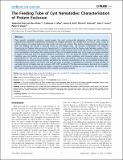Files in this item
The feeding tube of cyst nematodes : characterisation of protein exclusion
Item metadata
| dc.contributor.author | Eves-van den Akker, Sebastian | |
| dc.contributor.author | Lilley, Catherine J. | |
| dc.contributor.author | Ault, James R. | |
| dc.contributor.author | Ashcroft, Alison E. | |
| dc.contributor.author | Jones, John T. | |
| dc.contributor.author | Urwin, Peter E. | |
| dc.date.accessioned | 2015-08-12T13:40:03Z | |
| dc.date.available | 2015-08-12T13:40:03Z | |
| dc.date.issued | 2014-01-28 | |
| dc.identifier | 208027590 | |
| dc.identifier | 007d5a6e-9bb9-485e-b86c-510feeefb6e2 | |
| dc.identifier | 000330510000125 | |
| dc.identifier | 84900332488 | |
| dc.identifier.citation | Eves-van den Akker , S , Lilley , C J , Ault , J R , Ashcroft , A E , Jones , J T & Urwin , P E 2014 , ' The feeding tube of cyst nematodes : characterisation of protein exclusion ' , PLoS One , vol. 9 , no. 1 , e87289 . https://doi.org/10.1371/journal.pone.0087289 | en |
| dc.identifier.issn | 1932-6203 | |
| dc.identifier.uri | https://hdl.handle.net/10023/7197 | |
| dc.description | Date of Acceptance:19/12/2013 | en |
| dc.description.abstract | Plant parasitic nematodes comprise several groups; the most economically damaging of these are the sedentary endoparasites. Sedentary endoparasitic nematodes are obligate biotrophs and modify host root tissue, using a suite of effector proteins, to create a feeding site that is their sole source of nutrition. They feed by withdrawing host cell assimilate from the feeding site though a structure known as the feeding tube. The function, composition and molecular characteristics of feeding tubes are poorly characterised. It is hypothesised that the feeding tube facilitates uptake of host cell assimilate by acting as a molecular sieve. Several studies, using molecular mass as the sole indicator of protein size, have given contradictory results about the exclusion limits of the cyst nematode feeding tube. In this study we propose a method to predict protein size, based on protein database coordinates in silico. We tested the validity of these predictions using travelling wave ion mobility spectrometry - mass spectrometry, where predictions and measured values were within approximately 6%. We used the predictions, coupled with mass spectrometry, analytical ultracentrifugation and protein electrophoresis, to resolve previous conflicts and define the exclusion characteristics of the cyst nematode feeding tube. Heterogeneity was tested in the liquid, solid and gas phase to provide a comprehensive evaluation of three proteins of particular interest to feeding tube size exclusion, GFP, mRFP and Dual PI. The data and procedures described here could be applied to the design of plant expressed defence compounds intended for uptake into cyst nematodes. We also highlight the need to assess protein heterogeneity when creating novel fusion proteins. | |
| dc.format.extent | 9 | |
| dc.format.extent | 1286052 | |
| dc.language.iso | eng | |
| dc.relation.ispartof | PLoS One | en |
| dc.subject | Plant-parasitic nematodes | en |
| dc.subject | Green-fluorescent protein | en |
| dc.subject | Ion mobility measurements | en |
| dc.subject | Mass-spectrometry | en |
| dc.subject | Glomerular-filtration | en |
| dc.subject | Heterodera-schachtii | en |
| dc.subject | Arabidopsis-thaliana | en |
| dc.subject | Size-selectivity | en |
| dc.subject | Aggregation | en |
| dc.subject | Cells | en |
| dc.subject | QH301 Biology | en |
| dc.subject.lcc | QH301 | en |
| dc.title | The feeding tube of cyst nematodes : characterisation of protein exclusion | en |
| dc.type | Journal article | en |
| dc.contributor.institution | University of St Andrews. School of Biology | en |
| dc.contributor.institution | University of St Andrews. Biomedical Sciences Research Complex | en |
| dc.identifier.doi | 10.1371/journal.pone.0087289 | |
| dc.description.status | Peer reviewed | en |
This item appears in the following Collection(s)
Items in the St Andrews Research Repository are protected by copyright, with all rights reserved, unless otherwise indicated.

